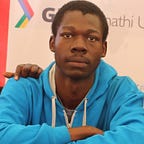Open Source Community, Basic Electronics & the Internet of Things
IoT Presentation at GDG DevFest Nakuru 2015
This post is part of a series of IoT notes that I prepared for the DevFest Season 2015.
DevFest Nakuru was held on the 17th of October 2015 at Egerton University. GDG DevFests are large, community-run events that can offer speaker sessions across multiple product areas, all-day hack-a-thons, code labs, and more.
They are normally powered by a shared belief that when developers come together to exchange ideas amazing things can happen .
A total of 139 young and Google-enthusiastic developers attended the event mainly from three different universities (Egerton University, Kabarak University and Dedan Kimathi University).
Overview of the Internet of Things
During this event, I gave a brief overview of open source electronics and the internet of things, specific use cases and opportunities across different industries. I explain the exciting present and the fascinating future of the Internet of Things covering how IoT is being implemented today, where the new sources of opportunity will be tomorrow and how different separate sectors of the economy can be transformed. I also touch on the challenges and complexity associated with the internet of things.
Google Brillo, Weave
I then talked about Brillo, the Google’s Android based OS used for embedded development — in particular for low-power IoT devices, and Weave, an IoT-oriented communication protocol. This is the communication language between the device and the cloud.
Open Source Community, Projects
Naturally, from childhood, people hate sharing. As with our toys, when building projects, people apply for patents as they don’t want anyone to have any idea how they made them. In contrast, the same people share almost every single details about their personal life.I guided them through the world of patents, how long it really takes copyrights products to appear in the marketplace, and how sharing can truly build profitable, growing companies.
I then took then through the following Copy Left Principles:
1. Providing the plans
2. Allowing modification
3. Being able to be sold
4. Propagating license
With or without a patent, the first three rules are going to happen. Engineers are going to reverse engineer ideas and sell it, projects both simple and complex. Open source hardware follows the first three principles with addition of the fourth. Any future idea of open source projects must be released under the same license.
In Open source hardware, design can be made publicly available so that anyone can study, modify, distribute, make, and sell the design or hardware based on that design. I gave them the various Open Source hardware project examples starting with The Large Hadron Collider in Switzerland. This is the world’s largest, most powerful and most complex experimental scientific endeavor ever conducted. It first started up on 10 September 2008. The LHC consists of a 27-kilometre ring of superconducting magnets with a number of accelerating structures to boost the energy of the particles along the way. Inside the accelerator, two high-energy particle beams travel at close to the speed of light before they are made to collide. Scientists are trying to find the Higgs boson(gods particle), an elementary particle in the Standard Model of particle physics. They were the first group to release open source hardware license.
I also talked about the benefits of open source.
a. It is a community. It enables people to learn from each other. The community members will help fellow engineers develop the projects.
b. Better quality products — Whenever there is an error, the community will help correct it. Engineers will also be able to get feedback from people who are using their open source product all the way during the development cycle.
c. Lower prices of products — Spend less money/Lower cost in development as the community help makes developments for you
d. It makes business focus
e. It makes companies to constantly innovate
Introduction to basic Electronics
I then took the developers through Electrical Engineering basics tailored specifically for web developers. This include a slight touch on signals (analogue and digital) and Pulse width Modulation, Resistors, Diodes, Current, Voltage, Power, among many other things. I help them have a basic understanding of the relationships between voltage, current, resistance, and power. The basic electronics concepts helps the developers to be familiar with how to safely connect peripherals to devices and begin writing apps that bring them to life.
Inputs and Outputs
The devices used to interact with the physical world contain components, or are connected to peripherals, that enable sensor input or actuator output. I talked about the hardware interface. Most hardware interfaces are serial interfaces. Serial interfaces generally use multiple wires to control the flow and timing of binary information along the primary data wire. IoT hardware platforms use a number of common interfaces. Sensor and actuator modules can support one or more of these interfaces. These include the Universal Serial Bus, the General-purpose input/output pins, I2C Inter-Integrated Circuit serial bus and the UART Universal Asynchronous Receiver/Transmitter devices.
I then introduced the developers to different micro-controllers such as Arduino and Intel Galileo.
I also talked about the Arduino syntax explaining the the two main functions, the Analogue and Digital read, Analogue and Digital write, the strings and control structures e.t.c
Let’s try it live! Standing with Ahmed
I then did a live demo of a Binary Digital Counter in honor of Ahmed Mohamed, a Texan teen in love with electronics who brought a homemade alarm clock to school in an attempt to ‘wow’ his engineering teacher. His school mistook his invention for a bomb, confiscating it and calling in police officers. The 14-year-old was handcuffed and escorted to a juvenile detention center.
We did the demo to encourage the inventive spirit and passion for technology and science.
Event Images
